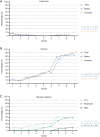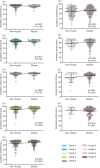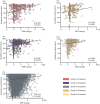The associations of high academic performance with childhood ametropia prevalence and myopia development in China
- PMID: 34268358
- PMCID: PMC8246175
- DOI: 10.21037/atm-20-8069
The associations of high academic performance with childhood ametropia prevalence and myopia development in China
Abstract
Background: To assess associations of high academic performance with ametropia prevalence and myopia development in Chinese schoolchildren.
Methods: This multicohort observational study was performed in Guangdong, China. We first performed a cross-sectional cohort analysis of students in grades 1 to 9 from Yangjiang to evaluate the relationship between academic performance and refractive status on a yearly basis. We also performed longitudinal analyses of students in Shenzhen to evaluate the trend of academic performance with refractive changes over a period of 33 months. All refractive statuses were measured using noncycloplegic autorefractors.
Results: A total of 32,360 children with or without myopia were recruited in this study (mean age 10.08 years, 18,360 males and 14,000 females). Cross-sectional cohort analyses in Yangjiang showed that the prevalence of hyperopia was associated with lower academic scores in grade one, the year students entered primary school (β=-0.04, P=0.01), whereas the prevalence of myopia was associated with higher academic scores in grade six and grade eight, the years in which students were about to take entrance examinations for junior high school or senior high school (β=0.020, P=0.038; β=0.041, P=0.002). Longitudinal analysis showed that in Shenzhen, faster myopia development was associated with better scores in all grades even after adjustments for BMI, outdoor activity time, screen time, reading time, and parental myopia (grade two at baseline: β=0.026, P<0.001; grade three at baseline: β=0.036, P=0.001; grade four at baseline: β=0.014, P<0.001; grade five at baseline: β=0.039, P<0.001; grade six at baseline: β=0.04, P<0.001).
Conclusions: Refractive errors correlated significantly with academic performance among schoolchildren in China. Children with high academic performance were more likely to have faster myopia development.
Keywords: Refractive error; academic performance; cohort study; hyperopia; myopia.
2021 Annals of Translational Medicine. All rights reserved.
Conflict of interest statement
Conflicts of Interest: All authors have completed the ICMJE uniform disclosure form (available at http://dx.doi.org/10.21037/atm-20-8069). The authors have no conflicts of interest to declare.
Figures



References
-
- Yu L, Suen HK. Historical and contemporary exam-driven education fever in China. KEDI Journal of Educational Policy 2005;2:17-33.
-
- Zhao X, Selman RL, Haste H. Academic stress in Chinese schools and a proposed preventive intervention program. Cogent Education 2015;2:1. 10.1080/2331186X.2014.1000477 - DOI
LinkOut - more resources
Full Text Sources
